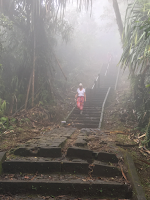Three weeks from tomorrow, the Friday before Christmas, I will take the light rail from my home to downtown's King Street Station. At 9:50 a.m., Amtrak's Coast Starlight will pull out of the station. Five meals and one night's sleep later, at 7:05 p.m., we will pull into the station in Oxnard, California, where I'll join my family for this year's Christmas celebration.
I could, of course, fly to nearby Santa Barbara in about two hours, but I won't (although I will fly back). I won't, because, when trains are involved, getting there is half the fun.
My longest trip ever by train was in 2008, when I traveled via Empire Builder and Lake Shore Limited from Seattle to Boston. My trip to Oxnard will be a quick jump by comparison. I often dream of something longer. Much longer.
My dreams are shared by others. Two days ago, the New York Times carried an article by a fellow who had traveled 8,980 miles by train in 13 days -- leaving New York City the day after the Trump victory a year ago. While he clearly loves trains, his primary objective was to meet a cross-section of Americans, to understand their lives and their fears -- to see why they voted the way they did.
The best place to meet on trains, as every train traveler knows, is the diner. Unless you're one of a party of four, you will be placed at a table with at least one stranger. If you're a solo traveler like me, you'll be seated with three strangers who may, or may not, know each other. Unless you stare out the window or into space, avoiding eye contact, you're bound to become involved in conversation.
For a non-gregarious person like myself, each seating in the diner thus becomes slightly intimidating. And yet, in few other social contexts is it so easy to start conversations with people you've never met. Part of the ease, I suppose, comes from the knowledge that it's extremely unlikely you'll ever meet them again.
The NYT writer* observed that in our fast-paced society, insofar as we talk to others at all, we rarely have the time or inclination to understand the people we talk to. We make quickie judgments about their intelligence, their status, their opinions. If we talk about something controversial, our own goal is to prove -- to ourselves, at least -- that we are "right" and they are "wrong."
I mourn the decline of complex truth, the ability to hold two sides of an argument in mind, the desire to understand rather than simply to be right. We have, for the most part, retreated into pure binary thinking.
Train travel -- in America, at least -- is slow and inefficient. You aren't going anywhere fast. You can't gracefully walk away from people you consider, at first glance, uninteresting or "wrong-headed." You're stuck with them for a meal. There's no way to escape; there's nowhere to go . Meals are slow and leisurely, because we all like not only to talk, but to look out the window at the passing scene, as we eat.
When you're stuck eating with someone, you begin learning trivial things about each other -- things that would never come up during a brief city encounter.
After a few days of the dining car routine I began to wonder if the train might be a salve for our national wound, bringing us into intimate conversation with unlikely interlocutors, and allowing us to see each other as human rather than as mere containers for ideology. On the train, I slowed down. I thought more deeply. I listened better, and longer.
Even with people whose politics he abhorred, "there was something about the person’s relationship to family, and loyalty to family, that I found deeply moving."
Slowing down, seeing the person in front of you as a fellow human, considering his way of thinking -- none of this will change your own beliefs. But it prevents you from demonizing those with whom you disagree. It keeps you civil. If it caught on, it could preserve us as a nation.
Of course, you can always avoid the diner and eat in your roomette or at your seat, staring contentedly out the window. At times, even a social scientist may feel the need to be alone in the universe. Either way, the train's a fine place to spend a day or two. Or more.
--------------------------------------
*Gabriel Kahane, "How the Amtrak Dining Car Could Heal the Nation," New York Times (Nov. 28, 2017).
















